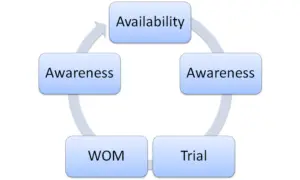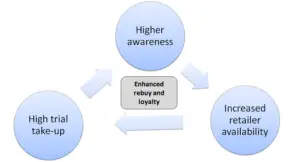Contents
Understanding ATAR factors in a marketing forecast
Possibly one of the more troublesome issues to consider when using the ATAR model for forecasting new products is how the four basic components – awareness, trial, availability and repeat/rebuy – impact each other.
Get the free tool for marketing sales and profit forecasts: Free Download: ATAR Model Excel Template
These ATAR factors are not independent
It would be a mistake to consider that these four marketing variables act independently in the marketplace. This is a common misinterpretation of using the ATAR forecasting approach that is driven by the source/data for each assumption.
As with any forecasting model, the accuracy of the underlying assumptions are critical in generating an overall reliable sales and profit forecast. Reliability is improved by providing supportive data and information to determine the assumptions been utilized.
In the case of the ATAR forecasting model, we typically use advertising/promotional spend (and experience) as an input into the estimation of the awareness percentage, likewise we would use the results of the concept test to help estimate likely trial take up, and so on.
As a result, we could end up with a series of assumptions that have been generated independently, when in the marketplace they will act in some synergistic fashion.
Let’s start with awareness. Obviously, in the early stage of the new product’s life, product/brand awareness is generally driven by the brand’s/firm’s promotional efforts and expenditure – and this usually becomes the basis of the awareness assumption used in the ATAR forecasting model.
However, as the product becomes adopted by consumers (by an initial trial), awareness is also driven by word-of-mouth from other consumers – therefore, a high trial rate should also result in a higher awareness level through word-of-mouth.
In this same scenario, the product being adopted (high trial rates) and being talked about (higher awareness) is far more likely to attract greater retailer take up.
Therefore, we have this synergistic situation where awareness, trial and availability are all supporting each other. It is also likely that this positive set of factors will also influence the rate of repeat purchases and ongoing customer loyalty.
This is why we cannot look at the estimation of awareness in isolation.
Obviously this is a very positive result and one that would be desired by the organization and the marketing team. However, as you can probably guess, this situation can easily work in reverse.
A poor trial take-up rate, may lead to a weak level of retailer interest (availability), which in combination will limit the potential for market awareness, and would also probably reduce the likelihood of repeat/rebuy purchases and ongoing customer loyalty.
Repeat/rebuy is slightly independent
Although still quite influenced by the other three factors as described above, probably the one factor that is a little bit more independent than the others is the repeat/rebuy component of the ATAR model.
This is because, at this stage of the customer’s journey, they have had direct experience with the product – as they have trialed the product in a purchase.
Therefore, depending upon their own level of customer satisfaction, they will either rebuy (or not) the product. In other words, they are more influenced by their own direct product experience than word-of-mouth comments.
How to determine these interrelated assumptions
Because of the interrelated nature of the ATAR forecasting components, there is a natural market advantage available to large firms/brands.
Large brands tend to have the ability to strongly deliver on each of the starting components of the ATAR (awareness, trial, availability) due to their strong brand equity, customer loyalty and existing retailer relationships. Therefore, we can assume some level of positive synergy for these market situations.
However, for smaller firms without strong brand equity and for firms/brands entering new markets or product categories, then we need to assume that the four ATAR components are far less likely to have a strong positive synergistic effect.
Related topics
- How the ATAR model works
- The ATAR formula
- Awareness in the forecast
- Product trials in the forecast
- Availability in the forecast
- Repeat/rebuys in the model


